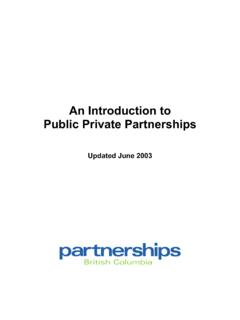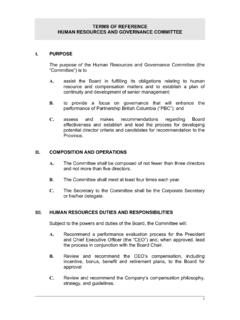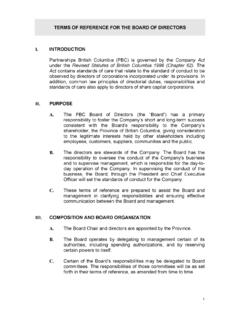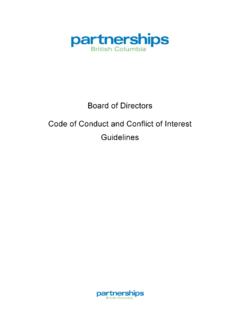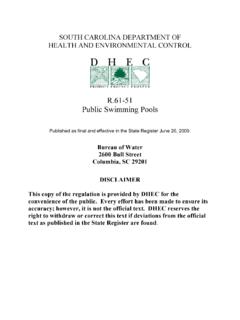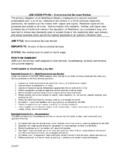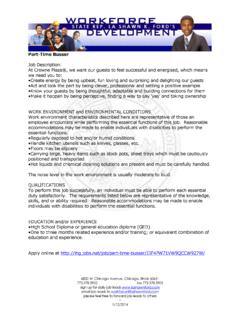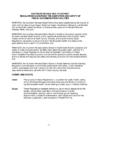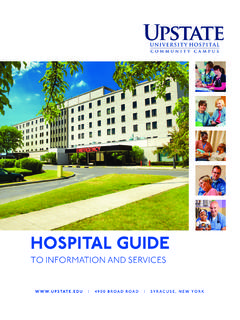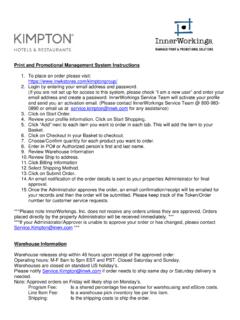Transcription of C4 MORGUE & AUTOPSY C4.1 SERVICE DESCRIPTION
1 Abbotsford Hospital & Cancer Centre Inc. Output Specification November 2004 Unauthorized Reproduction Prohibited Section 2 Clinical Services C Support Services C4 MORGUE & AUTOPSY 337 SERVICE DESCRIPTION Scope of Clinical Services This section C4 sets out the requirements for the Facility's comprehensive MORGUE and post mortem facilities to be achieved or accommodated by Project Co in providing the Works and the Services. The range of services to be provided within this component includes: Specimen handling area Administrative functions (documentation of incoming or outgoing bodies report preparation) Receiving, preparation and temporary storage of cadavers Investigations into the cause of death by performing a PM examination of the body (including forensic autopsies) The demonstration of PM findings in cases of clinical interest, for teaching purposes or forensic purposes Mobile radiography Photography Family/police viewing and/or identification of the body This component will provide facilities for the forensic AUTOPSY SERVICE for Fraser Valley area, however, the coroner's administrative base will be provided elsewhere.
2 A separate locked holding cooler will be provided in the component for forensic cases. Current Trends None Scope of Education Services This component will include resources in support of the following types/numbers of students: BCIT trainee, 1 at a time Pathology attendant trainee, 1 at a time Scope of Research Services None Specific Exclusions None Abbotsford Hospital & Cancer Centre Inc. Output Specification November 2004 Unauthorized Reproduction Prohibited Section 2 Clinical Services C Support Services C4 MORGUE & AUTOPSY 338 OPERATIONAL DESCRIPTION Minimum Hours of Operation Hours of operation for the component will vary with each SERVICE as follows: Body storage area.
3 24 hours/7 days/week Remaining areas ..0800h to 1600h/5 days/week Patient Management Processes Not applicable Patient Information Management Refer to Output Specifications, Section 3: Non-Clinical Services, subsection D1 Information Management; Section 5: Design and Technical, subsection Technology and Communication Systems; and Section 6: IT/Tel Services. Staff Work Processes Entrances Cadavers will arrive in this component from various Abbotsford Hospital locations ( , Inpatient Units, Surgical Suite, Emergency, etc.) or from the community. Bodies will be held in refrigerated storage until required for AUTOPSY or released to the coroner or funeral home. Up to three entrances are required: one for staff, one for the delivery of bodies from the hospital or community (if appropriate) and for collection by undertakers, and one for visiting relatives and friends. Bodies should not be taken in and out of the building within sight of patients and/or visitors.
4 The external entrance for the collection of bodies and, if appropriate, delivery of bodies will be covered and screened from the view of patients and the public. The layout should also prevent overlooking of SourceBodyStorageMortuaryViewingAutopsyR oom Patient Flow Diagram the body handling area within the building from outside by the provision of lobby doors or screening. The external entrance will be overlooked by the technician s office unless audio-visual intercoms are in operation. There will be sufficient space for large vehicles to manoeuvre. An exit to a subsidiary road, and nearby car parking space, is also desirable. All external entrances should normally be kept locked. The entrance for relatives, which may be via a lobby, should lead into the visitors waiting room. Communication devices with a clear and Abbotsford Hospital & Cancer Centre Inc. Output Specification November 2004 Unauthorized Reproduction Prohibited Section 2 Clinical Services C Support Services C4 MORGUE & AUTOPSY 339 appropriate notice will be provided at all entrances for visitors to summon the attention of mortuary staff.
5 Body Viewing Suite The body viewing suite should comprise, at the very least, a separate entrance, a waiting room, and a viewing room. In the waiting room and viewing room a serene and reassuring environment is desirable. The choice of suitable colours, textures and lighting is important. It will be possible to dim the lights in the viewing room. Ventilation will be such that comfortable conditions are maintained in these areas and should prevent the entry of odours from other parts of the facility. The waiting room should contain comfortable chairs and a small table. Lighting will be non-institutional with natural light where possible. The viewing room will be capable of minor adaptation to suit the needs of all religious beliefs and for devising more appropriate arrangements for viewing bodies of infants. Where facilities for ritual washing are required these will have to be sited in an area that is accessible to visitors and also suitable for wet working.
6 It should also be noted that religious beliefs may have an effect on the orientation of the body wash station. Body Store and Body Handling Area A refrigerated body store is required: To maintain bodies and/or fluids in a condition whereby the maximum scientific information can be obtained from a PM and subsequent analytical investigations To limit tissue decomposition while burial or cremation arrangements are being made To hold bodies and the occasional specimen for longer periods in conditions of security Bodies usually remain in the MORGUE for one to four days. Sometimes the period is longer if further investigations have to be carried out by the pathologist, or if the next-of-kin are difficult to trace. The body handling area will be adjacent to the AUTOPSY room. Space is required in the body handling area for parking and manoeuvring trolleys. Space is also required for the reception of bodies on trolleys from the Abbotsford Hospital, the labelling or identification of bodies and entering details in a record book, or computer, the placing of shrouds on bodies, the transfer of bodies to the refrigerated body store, the removal and transfer of bodies from the body store to the PM room (where double-ended body stores are not available), the removal of bodies from the store, and confirmation of identity before handing over to undertakers or for police identifications.
7 The PM room should accommodate mobile and fixed hoists, which will have implications on space requirements. The body store consists of seven labelled compartment bays, (refrigerated at approximately 4 C), each containing three racks for holding the body trays upon which bodies are stored. Compartment bays are to be double-ended as pass-through fridges; the latter requires additional space on the PM room side to allow for extraction of bodies, are preferable for reasons of hygiene and efficiency. One of the compartment bays will be deep-freeze and one extra wide compartment bay must be provided to accommodate obese bodies. All doors to the refrigerated compartment bays must open to give access to the body trays and also be constructed in such a manner that they will not fall closed while in use. All doors will be fitted with locks. High quality hinges and locks are an important consideration. Locks should Abbotsford Hospital & Cancer Centre Inc.
8 Output Specification November 2004 Unauthorized Reproduction Prohibited Section 2 Clinical Services C Support Services C4 MORGUE & AUTOPSY 340 also be operable from inside the compartment bay for safety purposes. All compartment bays will be capable of being drained. Internal rollers and racking holding body trays will be removable to permit clear entry to the compartment bay for cleaning purposes. The bottom tier of racking will be no lower than the lower position of the body hoist or adjustable height mortuary trolley, so that trays bearing bodies do not have to be lifted by the mortuary staff. The refrigeration plant must be fully accessible for maintenance. The frequent movement of MORGUE trolleys, which could be heavily-laden, and mobile hoists, has implications that must not be overlooked.
9 Corners, doors and certain areas of walls must be protected against damage. Doorways through which trolleys are to pass must be wide enough to reduce the chances of collision and consequent damage to property and injury to staff. AUTOPSY Room The PM room, which is also known as the AUTOPSY room, serves to carry out several functions. These include the opening of bodies, the weighing and dissection of organs, and demonstration of post mortems to clinical staff. Bodies are brought from the body store on a hydraulic body hoist or trolley and transferred on to a PM table. In the case of full body handling systems the body remains on the body tray during the PM, supported on the PM station. The dissection of organs should take place on a dissecting bench running along a length of wall. Bodies for examination will be drawn directly from a double-ended body storage compartment into the PM room. Space will be needed in the PM room for safely manoeuvring trolleys, for loading or transferring bodies onto the PM table or station, and for storing and using a second hoist (where used), without risk of accident or injury.
10 Where double-ended body storage compartments are not in use, bodies will be conveyed into the PM room on a trolley from the body handling area via a double-width doorway. Tissues, organs and/or fluids obtained during PM examinations are infused in fixative in various sized containers. This work will be carried out at the dissection bench. The samples may be held for a short time within the PM suite or specimen store prior to despatch to the pathology department or other departments. Adjustable height tables will be provided to comply with standards for working heights. Consideration should also be given to rotating tables. Each table should have a hot and cold water supply and a waste outlet of about 75mm diameter, fitted with a suitable, readily accessible trap and drain pipe. They will be fixed to the floor, located over a drain and supplied with water at low pressure. During an examination, there may be a need to dictate findings, take x-rays, examine x-ray films taken earlier, and use other portable electrical equipment.
